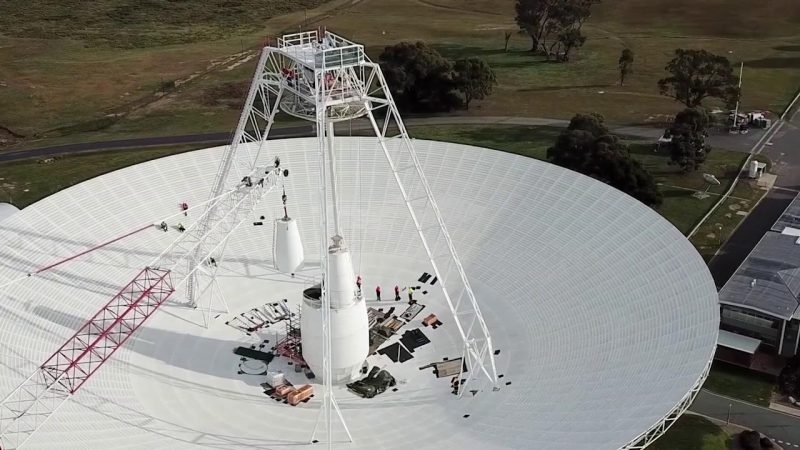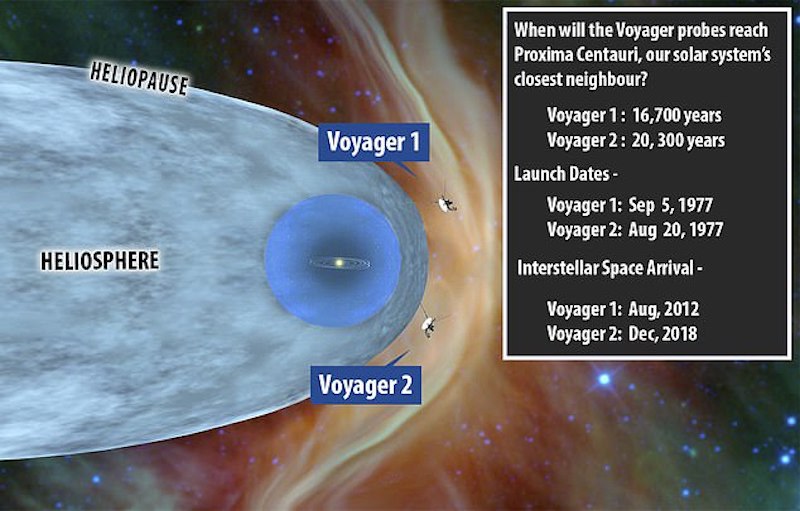

Artist’s concept showing the positions of the Voyager 1 and Voyager 2 probes, now both outside the heliosphere, or sphere of our sun’s influence. Image via NASA/ JPL-Caltech.
On October 29, 2020, NASA re-established contact with its Voyager 2 spacecraft, launched from Earth in 1977. The craft is now traveling more than 11.6 billion miles (18.8 billion km) from Earth. It is beyond the heliopause, or boundary region, where the sun’s influence ends and the interstellar medium begins. The 43-year-old space probe was left flying solo for 7 months while repairs were made to the radio antenna in that commands it. The only radio antenna that can command the space probe – the Deep Space Station 43 (DSS43) antenna in Canberra, Australia – has been offline since March.
The 2021 lunar calendars are here! Order yours before they’re gone. Makes a great gift!
Mission operators sent a series of test commands to Voyager 2 using the DSS43 antenna, which established a signal confirming the “call” was received. The spacecraft executed the commands without issue, according to a NASA statement.
Voyager 2 has been traveling through space since its launch in 1977, and is now more than 11.6 billion miles ( 18.8 billion km) from Earth. Voyager 2 entered interstellar space two years ago, in November 2018, when the spacecraft exited the heliosphere – the protective bubble of particles and magnetic fields created by the sun that surrounds the planets and the Kuiper Belt (the collection of small, icy bodies beyond Neptune’s orbit).

Crews conduct critical upgrades and repairs to the 230-foot-wide (70-meter-wide) radio antenna Deep Space Station 43 in Canberra, Australia. In this photo, one of the antenna’s white feed cones (which house parts of the antenna receivers) is being moved by a crane. Image via CSIRO/ NASA.
Since DSS43 went offline in mid-March for repairs, mission operators have been able to receive health updates and science data from Voyager 2, but they haven’t been able to send commands to the probe. The recent call to Voyager 2 was a test of new hardware installed on DSS43, which is part of NASA’s Deep Space Network, a collection of radio antenna facilities spaced equally around the globe in Canberra; Goldstone, California; and Madrid, Spain.
Among the upgrades to DSS43 are two new radio transmitters. One of them, which is used to talk with Voyager 2, hasn’t been replaced in over 47 years. Engineers have also upgraded heating and cooling equipment, power supply equipment, and other electronics needed to run the new transmitters. NASA said that the successful call to Voyager 2 is just one indication that the dish will be fully back online as planned in February 2021.

Voyager 2 launched in 1977 and reached interstellar space just two years ago. Image via Daily Mail.
Although both of the Voyager probes – Voyager 1, launched September 5, 1977, and Voyager 2, launched 16 days before its twin – have left the heliosphere, neither spacecraft has yet left the solar system, and won’t be leaving anytime soon. The boundary of the solar system is considered to be beyond the outer edge of the Oort Cloud, a collection of small objects that are still under the influence of the sun’s gravity. The width of the Oort Cloud is not known precisely, but it is estimated to begin at about 1,000 astronomical units (AU) from the sun and to extend to about 100,000 AU (1 AU is the distance from the sun to Earth). It will take about 300 years for Voyager 2 to reach the inner edge of the Oort Cloud and possibly 30,000 years to fly beyond it.
Both Voyager 2 and Voyager 1 have traveled well beyond their original destinations. The spacecraft were built to last five years and conduct close-up studies of Jupiter and Saturn. However, as the mission continued, additional flybys of the two outermost giant planets, Uranus and Neptune, proved possible. As the spacecraft flew across the solar system, remote-control reprogramming was used to give the Voyagers greater capabilities than they possessed when they left Earth. Their two-planet mission became a four-planet mission. Their five-year lifespans have stretched to 43 years, making Voyager 2 NASA’s longest-running mission.
Bottom line: On October 29, 2020, NASA re-established contact with its Voyager 2 spacecraft. The probe had been flying solo since March 2020 while repairs were made to the radio antenna in Australia used to control it.
from EarthSky https://ift.tt/2I8TXcs


Artist’s concept showing the positions of the Voyager 1 and Voyager 2 probes, now both outside the heliosphere, or sphere of our sun’s influence. Image via NASA/ JPL-Caltech.
On October 29, 2020, NASA re-established contact with its Voyager 2 spacecraft, launched from Earth in 1977. The craft is now traveling more than 11.6 billion miles (18.8 billion km) from Earth. It is beyond the heliopause, or boundary region, where the sun’s influence ends and the interstellar medium begins. The 43-year-old space probe was left flying solo for 7 months while repairs were made to the radio antenna in that commands it. The only radio antenna that can command the space probe – the Deep Space Station 43 (DSS43) antenna in Canberra, Australia – has been offline since March.
The 2021 lunar calendars are here! Order yours before they’re gone. Makes a great gift!
Mission operators sent a series of test commands to Voyager 2 using the DSS43 antenna, which established a signal confirming the “call” was received. The spacecraft executed the commands without issue, according to a NASA statement.
Voyager 2 has been traveling through space since its launch in 1977, and is now more than 11.6 billion miles ( 18.8 billion km) from Earth. Voyager 2 entered interstellar space two years ago, in November 2018, when the spacecraft exited the heliosphere – the protective bubble of particles and magnetic fields created by the sun that surrounds the planets and the Kuiper Belt (the collection of small, icy bodies beyond Neptune’s orbit).

Crews conduct critical upgrades and repairs to the 230-foot-wide (70-meter-wide) radio antenna Deep Space Station 43 in Canberra, Australia. In this photo, one of the antenna’s white feed cones (which house parts of the antenna receivers) is being moved by a crane. Image via CSIRO/ NASA.
Since DSS43 went offline in mid-March for repairs, mission operators have been able to receive health updates and science data from Voyager 2, but they haven’t been able to send commands to the probe. The recent call to Voyager 2 was a test of new hardware installed on DSS43, which is part of NASA’s Deep Space Network, a collection of radio antenna facilities spaced equally around the globe in Canberra; Goldstone, California; and Madrid, Spain.
Among the upgrades to DSS43 are two new radio transmitters. One of them, which is used to talk with Voyager 2, hasn’t been replaced in over 47 years. Engineers have also upgraded heating and cooling equipment, power supply equipment, and other electronics needed to run the new transmitters. NASA said that the successful call to Voyager 2 is just one indication that the dish will be fully back online as planned in February 2021.

Voyager 2 launched in 1977 and reached interstellar space just two years ago. Image via Daily Mail.
Although both of the Voyager probes – Voyager 1, launched September 5, 1977, and Voyager 2, launched 16 days before its twin – have left the heliosphere, neither spacecraft has yet left the solar system, and won’t be leaving anytime soon. The boundary of the solar system is considered to be beyond the outer edge of the Oort Cloud, a collection of small objects that are still under the influence of the sun’s gravity. The width of the Oort Cloud is not known precisely, but it is estimated to begin at about 1,000 astronomical units (AU) from the sun and to extend to about 100,000 AU (1 AU is the distance from the sun to Earth). It will take about 300 years for Voyager 2 to reach the inner edge of the Oort Cloud and possibly 30,000 years to fly beyond it.
Both Voyager 2 and Voyager 1 have traveled well beyond their original destinations. The spacecraft were built to last five years and conduct close-up studies of Jupiter and Saturn. However, as the mission continued, additional flybys of the two outermost giant planets, Uranus and Neptune, proved possible. As the spacecraft flew across the solar system, remote-control reprogramming was used to give the Voyagers greater capabilities than they possessed when they left Earth. Their two-planet mission became a four-planet mission. Their five-year lifespans have stretched to 43 years, making Voyager 2 NASA’s longest-running mission.
Bottom line: On October 29, 2020, NASA re-established contact with its Voyager 2 spacecraft. The probe had been flying solo since March 2020 while repairs were made to the radio antenna in Australia used to control it.
from EarthSky https://ift.tt/2I8TXcs

Aucun commentaire:
Enregistrer un commentaire